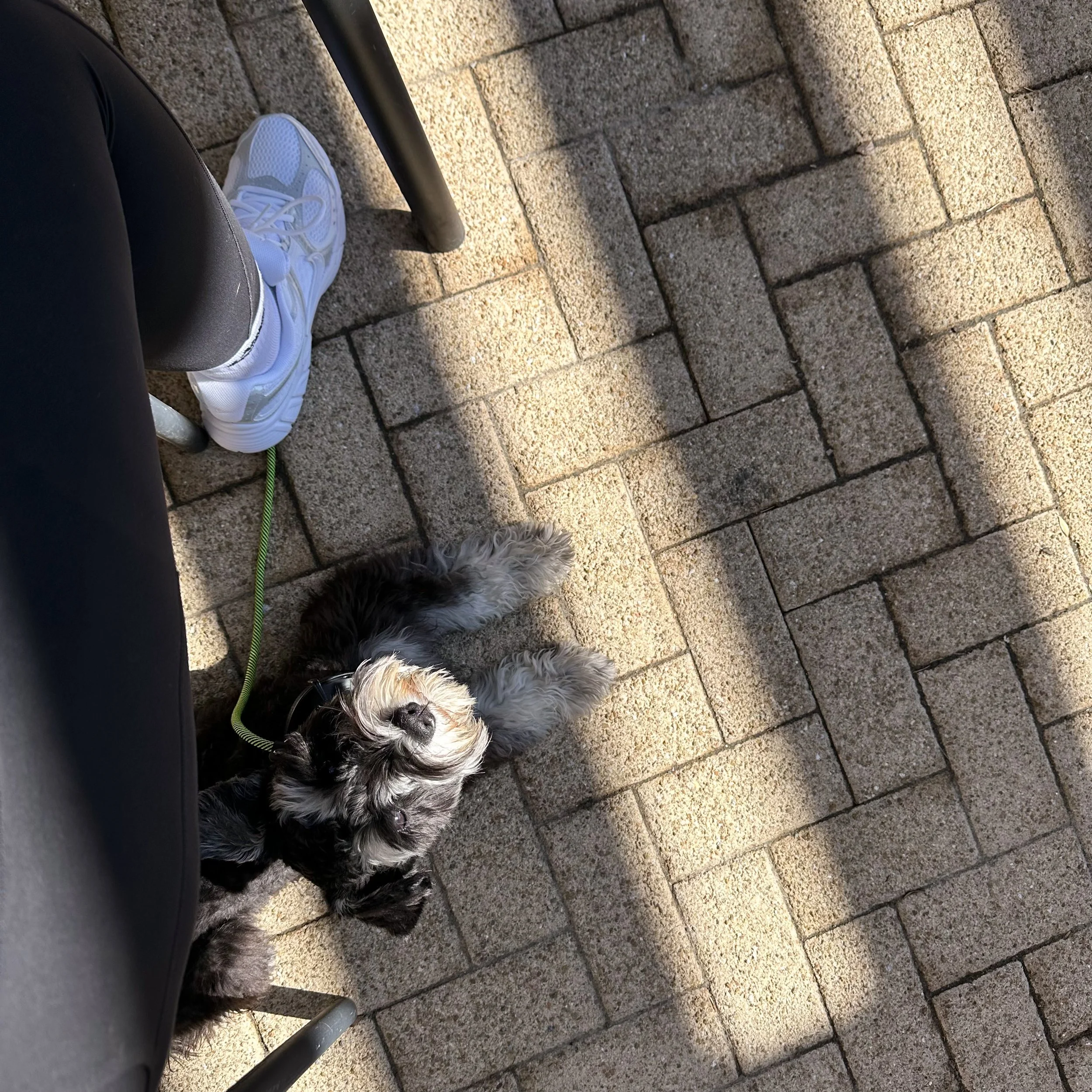Teaching Your Dog to Settle Anywhere
“When I’m calm, my dogs should be calm. Tethering and sit on the dog are key until that becomes habit”
Sit on the dog- my slightly adjusted version. This is one of my favorite foundation exercises for helping dogs learn to just exist calmly around their humans. I recommend starting this right away for any dog struggling with overstimulation, attention-seeking, or general restlessness. Every single dog that passes through my hands experiences this exercise daily, if not more.
This exercise is how I turn my overstimulated board and trains into dogs who people say “wow, they’re so calm” as they pass by… before I’ve even started any real training!
Once you’ve done it a few times, you can practice it without even thinking. For me, it’s not even training. It’s just: We’re taking a break, I step on the leash and keep the dog calm while I catch up on texts or emails.
Here’s how I teach it:
Step on your dog’s leash so there’s just enough slack that if they sit or lie down near you, the leash stays relaxed—but if they start to wander, there’s gentle tension that prevents them from leaving your space. You're not pinning them in place, just creating a clear boundary.
Then? Ignore them.
Seriously. No commands, no petting, no treats, no shushing, no “good boys.” You can scroll your phone, answer emails, eat lunch (although this might not help your dog early on!), or watch TV. The goal here is to give your dog the space to settle on their own without your help.
I typically have owners do this for about 20–30 minutes a day, ideally while they’re already doing something sedentary. The session should end on a calm note—ideally your dog is asleep, but at minimum they should be in a calm state: sitting or lying down quietly, not whining, pacing, or trying to engage with you. This means that if you’re at minute thirty, but your dog is still restless… Have someone bring you a book and get comfy.
If you get to the twenty five minute mark of so and feel that your dog absolutely won’t be settling any time soon, just end on a down swing. You’ll see this in my video with the golden retriever below, I had to get going and she was not laying down for more than thirty seconds for the past forty minutes. Instead, I just waited until she sat calmly for a moment and got up. I noted that for next time- knowing that she needs more practice with lower distractions.
It’s important to practice this regularly at home until your dog can settle easily and consistently-usually around a week of good, calm reps is solid. Once that’s happening, you can start slowly introducing new environments. Start small: a quiet park once or twice, then maybe a low-traffic public space. In Phoenixville, Bluebird Distilling on a weekday afternoon is a great starter option- it’s relaxed, not too crowded, and you won’t be rushed. In King of Prussia, City Works tends to be low-key during the day and has an enclosed patio, which helps set your dog up for success.
Remember that this is a cue to the dog that it’s calm time, so even when you do move to using this in real life, avoid letting people pet your dog or letting dogs walk up to them during this time. If you do, give them a release cue instead of just letting them get up and say hi to people on their terms. This keeps things clear for them and maintains all of your hard work!
The key is progressing slowly and not trying to use this exercise in high-distraction “real life” situations—like when you’re genuinely busy or focused—until your dog is mostly reliable and able to settle with minimal input from you.
If your dog starts chewing the leash, jumping on you, or barking at you, you can apply a bit more leash pressure—enough to make those behaviors less comfortable. No corrections or harsh pop—just pressure and release. A chew-proof leash (like a coated cable lead) can make this easier for determined chewers.
Some dogs may fall asleep in five minutes. Others might fidget, whine, or test the boundary for a while before settling. That’s okay. Stick with it. You’re teaching your dog an incredibly valuable skill: how to turn off their own brain and just be.
If your dog is really struggling with this, don’t be afraid to reach out—I’d rather give you tailored guidance than have you both stuck in a battle.
This isn’t a flashy obedience command. It’s not a trick. But it builds the kind of calm, respectful, relaxed relationship that makes do anything, go anywhere dogs.

